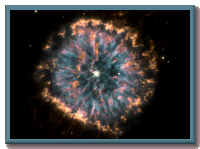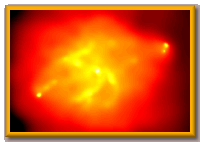 |
|
NGC 6751--another nebula, with a dying star at its center. (Hubble)
|
As we look out into space we find a Universe far more dynamic and violent than we ever imagined. For short periods, mysterious blasts of energy called "gamma ray bursts" outshine the light of whole galaxies. There are vast jets of matter blasting out of the center of other galaxies. Over millennia, galaxies themselves collide, making up the bizarre and beautiful variety of shapes we see through telescopes. Perhaps still more amazing, we're now convinced that what we see in not all there is.
In the past decade we have been in a period of time like that during Copernicus' and Galileo's: most astronomers now think that what we see is just the icing on the cake, the bright lights on a dark Christmas tree, the tip of the iceberg. They believe that stars and galaxies and jets of energy are all, in fact, structured by forms of matter and energy we don't yet understand. And yet, with the new telescopes and ideas they're developing, they say we're in the midst of a golden age of astronomy, made possible by a mix of new observations and new theories, a fertile blend of cosmology--the study of the Universe on the very largest scale--and particle physics, exploring the tiniest phenomena we know of.
